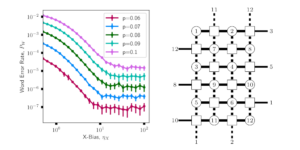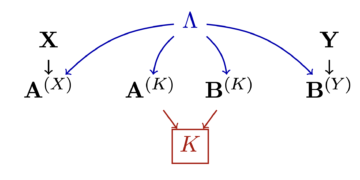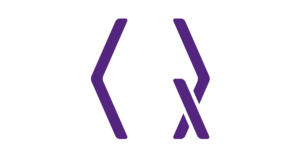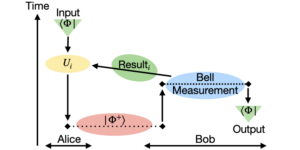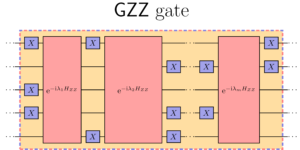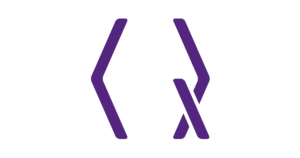1PsiQuantum, 700 Hansen Way, Palo Alto, CA 94304, USA
2QC Ware Corp, Palo Alto, CA 94306, USA
3Quantum Lab, Boehringer Ingelheim, 55218 Ingelheim am Rhein, Germany
Find this paper interesting or want to discuss? Scite or leave a comment on SciRate.
Abstract
Over the past three decades significant reductions have been made to the cost of estimating ground-state energies of molecular Hamiltonians with quantum computers. However, comparatively little attention has been paid to estimating the expectation values of other observables with respect to said ground states, which is important for many industrial applications. In this work we present a novel expectation value estimation (EVE) quantum algorithm which can be applied to estimate the expectation values of arbitrary observables with respect to any of the system’s eigenstates. In particular, we consider two variants of EVE: std-EVE, based on standard quantum phase estimation, and QSP-EVE, which utilizes quantum signal processing (QSP) techniques. We provide rigorous error analysis for both both variants and minimize the number of individual phase factors for QSPEVE. These error analyses enable us to produce constant-factor quantum resource estimates for both std-EVE and QSP-EVE across a variety of molecular systems and observables. For the systems considered, we show that QSP-EVE reduces (Toffoli) gate counts by up to three orders of magnitude and reduces qubit width by up to 25% compared to std-EVE. While estimated resource counts remain far too high for the first generations of fault-tolerant quantum computers, our estimates mark a first of their kind for both the application of expectation value estimation and modern QSP-based techniques.
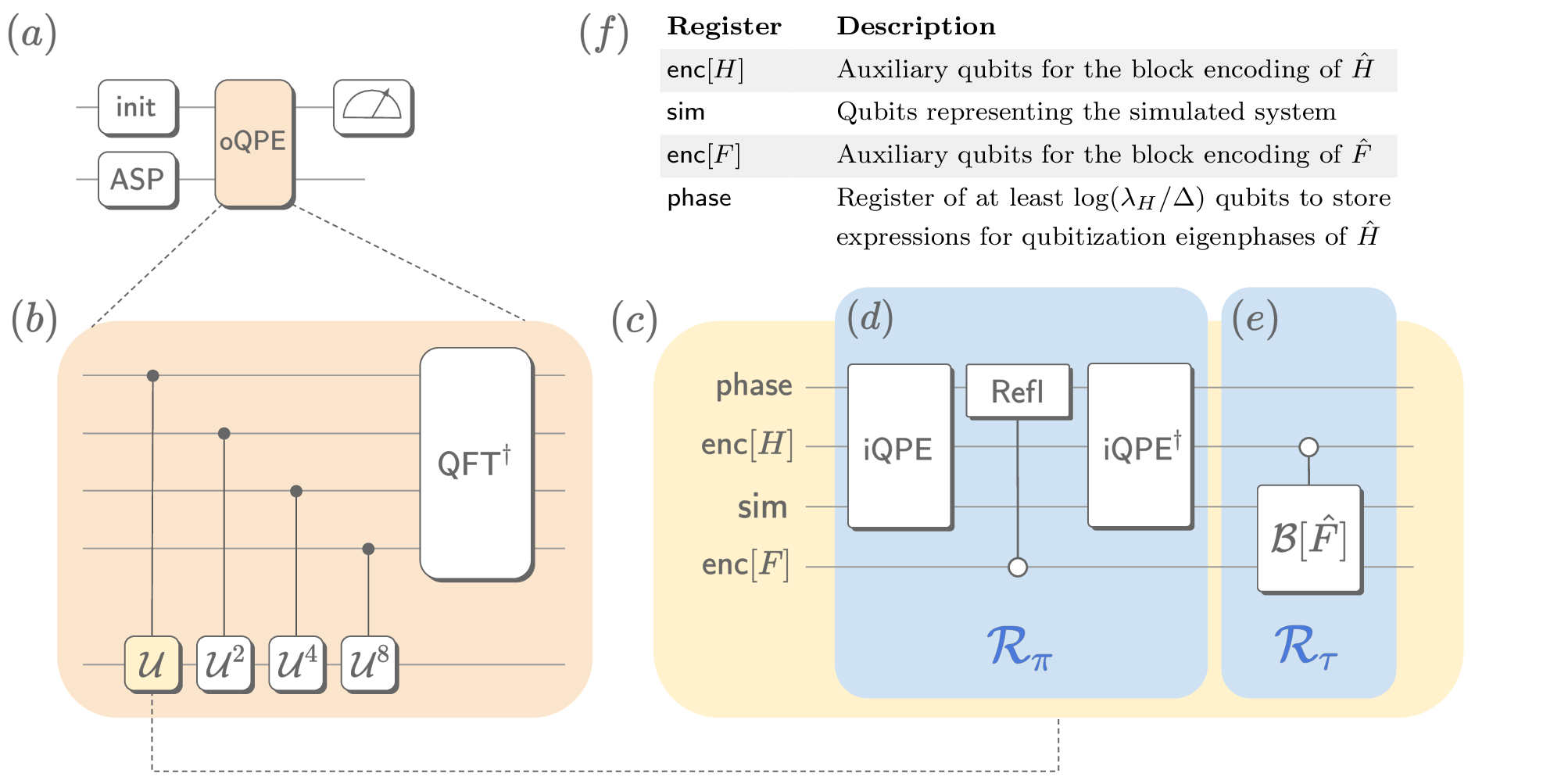
► BibTeX data
► References
[1] David Poulin, Matthew B. Hastings, Dave Wecker, Nathan Wiebe, Andrew C. Doberty, and Matthias Troyer. “The trotter step size required for accurate quantum simulation of quantum chemistry”. Quantum Info. Comput. 15, 361–384 (2015).
https://doi.org/10.5555/2871401.2871402
[2] Markus Reiher, Nathan Wiebe, Krysta M. Svore, Dave Wecker, and Matthias Troyer. “Elucidating reaction mechanisms on quantum computers”. Proceedings of the National Academy of Sciences 114, 7555–7560 (2017).
https://doi.org/10.1073/pnas.1619152114
[3] Ryan Babbush, Craig Gidney, Dominic W Berry, Nathan Wiebe, Jarrod McClean, Alexandru Paler, Austin Fowler, and Hartmut Neven. “Encoding electronic spectra in quantum circuits with linear T complexity”. Physical Review X 8, 041015 (2018).
https://doi.org/10.1103/PhysRevX.8.041015
[4] Dominic W. Berry, Craig Gidney, Mario Motta, Jarrod R. McClean, and Ryan Babbush. “Qubitization of arbitrary basis quantum chemistry leveraging sparsity and low rank factorization”. Quantum 3, 208 (2019).
https://doi.org/10.22331/q-2019-12-02-208
[5] Joonho Lee, Dominic W. Berry, Craig Gidney, William J. Huggins, Jarrod R. McClean, Nathan Wiebe, and Ryan Babbush. “Even more efficient quantum computations of chemistry through tensor hypercontraction”. PRX Quantum 2, 030305 (2021).
https://doi.org/10.1103/PRXQuantum.2.030305
[6] Yuan Su, Dominic W. Berry, Nathan Wiebe, Nicholas Rubin, and Ryan Babbush. “Fault-tolerant quantum simulations of chemistry in first quantization”. PRX Quantum 2, 040332 (2021).
https://doi.org/10.1103/PRXQuantum.2.040332
[7] Isaac H. Kim, Ye-Hua Liu, Sam Pallister, William Pol, Sam Roberts, and Eunseok Lee. “Fault-tolerant resource estimate for quantum chemical simulations: Case study on li-ion battery electrolyte molecules”. Phys. Rev. Research 4, 023019 (2022).
https://doi.org/10.1103/PhysRevResearch.4.023019
[8] Alain Delgado, Pablo A. M. Casares, Roberto dos Reis, Modjtaba Shokrian Zini, Roberto Campos, Norge Cruz-Hernández, Arne-Christian Voigt, Angus Lowe, Soran Jahangiri, M. A. Martin-Delgado, Jonathan E. Mueller, and Juan Miguel Arrazola. “Simulating key properties of lithium-ion batteries with a fault-tolerant quantum computer”. Phys. Rev. A 106, 032428 (2022).
https://doi.org/10.1103/PhysRevA.106.032428
[9] Vera von Burg, Guang Hao Low, Thomas Häner, Damian S. Steiger, Markus Reiher, Martin Roetteler, and Matthias Troyer. “Quantum computing enhanced computational catalysis”. Phys. Rev. Res. 3, 033055 (2021).
https://doi.org/10.1103/PhysRevResearch.3.033055
[10] Joshua J. Goings, Alec White, Joonho Lee, Christofer S. Tautermann, Matthias Degroote, Craig Gidney, Toru Shiozaki, Ryan Babbush, and Nicholas C. Rubin. “Reliably assessing the electronic structure of cytochrome p450 on today’s classical computers and tomorrow’s quantum computers”. Proceedings of the National Academy of Sciences 119, e2203533119 (2022).
https://doi.org/10.1073/pnas.2203533119
[11] Thomas E O’Brien, Michael Streif, Nicholas C Rubin, Raffaele Santagati, Yuan Su, William J Huggins, Joshua J Goings, Nikolaj Moll, Elica Kyoseva, Matthias Degroote, et al. “Efficient quantum computation of molecular forces and other energy gradients”. Phys. Rev. Res. 4, 043210 (2022).
https://doi.org/10.1103/PhysRevResearch.4.043210
[12] Christopher J Cramer. “Essentials of computational chemistry: theories and models”. John Wiley & Sons. (2013). url: https://www.wiley.com/en-cn/Essentials+of+Computational+Chemistry:+Theories+and+Models,+2nd+Edition-p-9780470091821.
https://www.wiley.com/en-cn/Essentials+of+Computational+Chemistry:+Theories+and+Models,+2nd+Edition-p-9780470091821
[13] Raffaele Santagati, Alan Aspuru-Guzik, Ryan Babbush, Matthias Degroote, Leticia Gonzalez, Elica Kyoseva, Nikolaj Moll, Markus Oppel, Robert M. Parrish, Nicholas C. Rubin, Michael Streif, Christofer S. Tautermann, Horst Weiss, Nathan Wiebe, and Clemens Utschig-Utschig. “Drug design on quantum computers” (2023). arXiv:2301.04114.
arXiv:2301.04114
[14] Clifford W Fong. “Permeability of the blood–brain barrier: molecular mechanism of transport of drugs and physiologically important compounds”. The Journal of membrane biology 248, 651–669 (2015).
https://doi.org/10.1007/s00232-015-9778-9
[15] Emanuel Knill, Gerardo Ortiz, and Rolando D. Somma. “Optimal quantum measurements of expectation values of observables”. Physical Review A 75, 012328 (2007).
https://doi.org/10.1103/physreva.75.012328
[16] Gilles Brassard, Peter Hoyer, Michele Mosca, and Alain Tapp. “Quantum amplitude amplification and estimation”. Contemporary Mathematics 305, 53–74 (2002).
https://doi.org/10.1090/conm/305/05215
[17] A. Yu. Kitaev. “Quantum measurements and the Abelian Stabilizer Problem” (1995). arXiv:quant-ph/9511026.
arXiv:quant-ph/9511026
[18] David Poulin and Pawel Wocjan. “Preparing Ground States of Quantum Many-Body Systems on a Quantum Computer”. Physical Review Letters 102, 130503 (2009).
https://doi.org/10.1103/physrevlett.102.130503
[19] David Poulin, Alexei Kitaev, Damian S. Steiger, Matthew B. Hastings, and Matthias Troyer. “Quantum algorithm for spectral measurement with a lower gate count”. Phys. Rev. Lett. 121, 010501 (2018).
https://doi.org/10.1103/PhysRevLett.121.010501
[20] Yimin Ge, Jordi Tura, and J. Ignacio Cirac. “Faster ground state preparation and high-precision ground energy estimation with fewer qubits”. Journal of Mathematical Physics 60, 022202 (2019).
https://doi.org/10.1063/1.5027484
[21] Lin Lin and Yu Tong. “Near-optimal ground state preparation”. Quantum 4, 372 (2020).
https://doi.org/10.22331/q-2020-12-14-372
[22] Ruizhe Zhang, Guoming Wang, and Peter Johnson. “Computing Ground State Properties with Early Fault-Tolerant Quantum Computers”. Quantum 6, 761 (2022).
https://doi.org/10.22331/q-2022-07-11-761
[23] Emanuel Knill, Gerardo Ortiz, and Rolando D. Somma. “Optimal quantum measurements of expectation values of observables”. Phys. Rev. A 75, 012328 (2007).
https://doi.org/10.1103/PhysRevA.75.012328
[24] András Gilyén, Yuan Su, Guang Hao Low, and Nathan Wiebe. “Quantum singular value transformation and beyond: exponential improvements for quantum matrix arithmetics”. In Proceedings of the 51st Annual ACM SIGACT Symposium on Theory of Computing. ACM (2019).
[25] Patrick Rall. “Quantum algorithms for estimating physical quantities using block encodings”. Phys. Rev. A 102, 022408 (2020).
https://doi.org/10.1103/PhysRevA.102.022408
[26] William J. Huggins, Kianna Wan, Jarrod McClean, Thomas E. O’Brien, Nathan Wiebe, and Ryan Babbush. “Nearly optimal quantum algorithm for estimating multiple expectation values”. Phys. Rev. Lett. 129, 240501 (2022).
https://doi.org/10.1103/PhysRevLett.129.240501
[27] Arjan Cornelissen, Yassine Hamoudi, and Sofiene Jerbi. “Near-optimal quantum algorithms for multivariate mean estimation”. In Proceedings of the 54th Annual ACM SIGACT Symposium on Theory of Computing. Page 33–43. STOC 2022New York, NY, USA (2022). Association for Computing Machinery.
https://doi.org/10.1145/3519935.3520045
[28] Guang Hao Low and Isaac L. Chuang. “Optimal hamiltonian simulation by quantum signal processing”. Phys. Rev. Lett. 118, 010501 (2017).
https://doi.org/10.1103/PhysRevLett.118.010501
[29] Patrick Rall. “Faster Coherent Quantum Algorithms for Phase, Energy, and Amplitude Estimation”. Quantum 5, 566 (2021).
https://doi.org/10.22331/q-2021-10-19-566
[30] John M. Martyn, Zane M. Rossi, Andrew K. Tan, and Isaac L. Chuang. “Grand unification of quantum algorithms”. PRX Quantum 2, 040203 (2021).
https://doi.org/10.1103/PRXQuantum.2.040203
[31] Wim van Dam, G. Mauro D’Ariano, Artur Ekert, Chiara Macchiavello, and Michele Mosca. “Optimal quantum circuits for general phase estimation”. Phys. Rev. Lett. 98, 090501 (2007).
https://doi.org/10.1103/PhysRevLett.98.090501
[32] Gumaro Rendon, Taku Izubuchi, and Yuta Kikuchi. “Effects of cosine tapering window on quantum phase estimation”. Phys. Rev. D 106, 034503 (2022).
https://doi.org/10.1103/PhysRevD.106.034503
[33] Kosuke Mitarai, Kiichiro Toyoizumi, and Wataru Mizukami. “Perturbation theory with quantum signal processing”. Quantum 7, 1000 (2023).
https://doi.org/10.22331/q-2023-05-12-1000
[34] Dominic W. Berry, Mária Kieferová, Artur Scherer, Yuval R. Sanders, Guang Hao Low, Nathan Wiebe, Craig Gidney, and Ryan Babbush. “Improved techniques for preparing eigenstates of fermionic hamiltonians”. npj Quantum Information 4, 22 (2018).
https://doi.org/10.1038/s41534-018-0071-5
[35] Guang Hao Low and Isaac L. Chuang. “Hamiltonian Simulation by Qubitization”. Quantum 3, 163 (2019).
https://doi.org/10.22331/q-2019-07-12-163
[36] Yulong Dong, Lin Lin, and Yu Tong. “Ground-state preparation and energy estimation on early fault-tolerant quantum computers via quantum eigenvalue transformation of unitary matrices”. PRX Quantum 3, 040305 (2022).
https://doi.org/10.1103/PRXQuantum.3.040305
[37] Earl T Campbell. “Early fault-tolerant simulations of the hubbard model”. Quantum Science and Technology 7, 015007 (2021).
https://doi.org/10.1088/2058-9565/ac3110
[38] Richard Cleve, Artur Ekert, Chiara Macchiavello, and Michele Mosca. “Quantum algorithms revisited”. Proceedings of the Royal Society of London. Series A: Mathematical, Physical and Engineering Sciences 454, 339–354 (1998).
https://doi.org/10.1098/rspa.1998.0164
[39] Craig Gidney. “Halving the cost of quantum addition”. Quantum 2, 74 (2018).
https://doi.org/10.22331/q-2018-06-18-74
[40] Jiasu Wang, Yulong Dong, and Lin Lin. “On the energy landscape of symmetric quantum signal processing”. Quantum 6, 850 (2022).
https://doi.org/10.22331/q-2022-11-03-850
[41] Guang Hao Low. “Quantum signal processing by single-qubit dynamics”. PhD thesis. Massachusetts Institute of Technology. (2017).
[42] Yulong Dong, Xiang Meng, K. Birgitta Whaley, and Lin Lin. “Efficient phase-factor evaluation in quantum signal processing”. Physical Review A 103, 042419 (2021).
https://doi.org/10.1103/physreva.103.042419
[43] Yulong Dong, Lin Lin, Hongkang Ni, and Jiasu Wang. “Infinite quantum signal processing” (2022). arXiv:2209.10162.
arXiv:2209.10162
[44] Diptarka Hait and Martin Head-Gordon. “How accurate is density functional theory at predicting dipole moments? An assessment using a new database of 200 benchmark values”. Journal of Chemical Theory and Computation 14, 1969–1981 (2018).
https://doi.org/10.1021/acs.jctc.7b01252
[45] Qiming Sun, Xing Zhang, Samragni Banerjee, Peng Bao, Marc Barbry, Nick S. Blunt, Nikolay A. Bogdanov, George H. Booth, Jia Chen, Zhi-Hao Cui, Janus J. Eriksen, Yang Gao, Sheng Guo, Jan Hermann, Matthew R. Hermes, Kevin Koh, Peter Koval, Susi Lehtola, Zhendong Li, Junzi Liu, Narbe Mardirossian, James D. McClain, Mario Motta, Bastien Mussard, Hung Q. Pham, Artem Pulkin, Wirawan Purwanto, Paul J. Robinson, Enrico Ronca, Elvira R. Sayfutyarova, Maximilian Scheurer, Henry F. Schurkus, James E. T. Smith, Chong Sun, Shi-Ning Sun, Shiv Upadhyay, Lucas K. Wagner, Xiao Wang, Alec White, James Daniel Whitfield, Mark J. Williamson, Sebastian Wouters, Jun Yang, Jason M. Yu, Tianyu Zhu, Timothy C. Berkelbach, Sandeep Sharma, Alexander Yu. Sokolov, and Garnet Kin-Lic Chan. “Recent developments in the PySCF program package”. The Journal of Chemical Physics 153, 024109 (2020).
https://doi.org/10.1063/5.0006074
[46] Qiming Sun, Timothy C. Berkelbach, Nick S. Blunt, George H. Booth, Sheng Guo, Zhendong Li, Junzi Liu, James D. McClain, Elvira R. Sayfutyarova, Sandeep Sharma, Sebastian Wouters, and Garnet Kin-Lic Chan. “Pyscf: the python-based simulations of chemistry framework”. WIREs Computational Molecular Science 8, e1340 (2018).
https://doi.org/10.1002/wcms.1340
[47] Huanchen Zhai and Garnet Kin-Lic Chan. “Low communication high performance ab initio density matrix renormalization group algorithms”. J. Chem. Phys. 154, 224116 (2021).
https://doi.org/10.1063/5.0050902
[48] Dominik Marx and Jurg Hutter. “Ab initio molecular dynamics: Theory and implementation”. Modern methods and algorithms of quantum chemistry 1, 141 (2000).
https://doi.org/10.1017/CBO9780511609633
[49] J. C. Slater. “The virial and molecular structure”. The Journal of Chemical Physics 1, 687–691 (1933).
https://doi.org/10.1063/1.1749227
[50] Jeffrey Cohn, Mario Motta, and Robert M. Parrish. “Quantum filter diagonalization with compressed double-factorized hamiltonians”. PRX Quantum 2, 040352 (2021).
https://doi.org/10.1103/PRXQuantum.2.040352
[51] Guang Hao Low, Vadym Kliuchnikov, and Luke Schaeffer. “Trading T-gates for dirty qubits in state preparation and unitary synthesis” (2018). arXiv:1812.00954.
arXiv:1812.00954
Cited by
[1] Ignacio Loaiza and Artur F. Izmaylov, “Block-Invariant Symmetry Shift: Preprocessing Technique for Second-Quantized Hamiltonians to Improve Their Decompositions to Linear Combination of Unitaries”, Journal of Chemical Theory and Computation acs.jctc.3c00912 (2023).
[2] Alexander M. Dalzell, Sam McArdle, Mario Berta, Przemyslaw Bienias, Chi-Fang Chen, András Gilyén, Connor T. Hann, Michael J. Kastoryano, Emil T. Khabiboulline, Aleksander Kubica, Grant Salton, Samson Wang, and Fernando G. S. L. Brandão, “Quantum algorithms: A survey of applications and end-to-end complexities”, arXiv:2310.03011, (2023).
[3] Cristian L. Cortes, Matthias Loipersberger, Robert M. Parrish, Sam Morley-Short, William Pol, Sukin Sim, Mark Steudtner, Christofer S. Tautermann, Matthias Degroote, Nikolaj Moll, Raffaele Santagati, and Michael Streif, “Fault-tolerant quantum algorithm for symmetry-adapted perturbation theory”, arXiv:2305.07009, (2023).
[4] Sophia Simon, Raffaele Santagati, Matthias Degroote, Nikolaj Moll, Michael Streif, and Nathan Wiebe, “Improved precision scaling for simulating coupled quantum-classical dynamics”, arXiv:2307.13033, (2023).
[5] Ignacio Loaiza and Artur F. Izmaylov, “Block-Invariant Symmetry Shift: Preprocessing technique for second-quantized Hamiltonians to improve their decompositions to Linear Combination of Unitaries”, arXiv:2304.13772, (2023).
The above citations are from Crossref’s cited-by service (last updated successfully 2023-11-13 12:50:11) and SAO/NASA ADS (last updated successfully 2023-11-13 12:50:12). The list may be incomplete as not all publishers provide suitable and complete citation data.
This Paper is published in Quantum under the Creative Commons Attribution 4.0 International (CC BY 4.0) license. Copyright remains with the original copyright holders such as the authors or their institutions.
- SEO Powered Content & PR Distribution. Get Amplified Today.
- PlatoData.Network Vertical Generative Ai. Empower Yourself. Access Here.
- PlatoAiStream. Web3 Intelligence. Knowledge Amplified. Access Here.
- PlatoESG. Carbon, CleanTech, Energy, Environment, Solar, Waste Management. Access Here.
- PlatoHealth. Biotech and Clinical Trials Intelligence. Access Here.
- Source: https://quantum-journal.org/papers/q-2023-11-06-1164/
- :has
- :is
- :not
- $UP
- 1
- 10
- 11
- 114
- 118
- 12
- 121
- 13
- 14
- 15%
- 16
- 17
- 19
- 1933
- 1995
- 1998
- 20
- 200
- 2000
- 2006
- 2013
- 2015
- 2017
- 2018
- 2019
- 2020
- 2021
- 2022
- 2023
- 22
- 23
- 24
- 25
- 26%
- 27
- 28
- 29
- 30
- 31
- 32
- 33
- 35%
- 36
- 39
- 40
- 41
- 49
- 50
- 51
- 60
- 7
- 700
- 75
- 8
- 9
- 98
- a
- above
- ABSTRACT
- Academy
- access
- accurate
- ACM
- across
- addition
- affiliations
- AL
- Alan
- Alexander
- algorithm
- algorithms
- All
- am
- Amplification
- an
- Analyses
- analysis
- and
- Andrew
- annual
- any
- Application
- applications
- applied
- ARE
- AS
- Assessing
- assessment
- Association
- At
- attention
- austin
- author
- authors
- barrier
- based
- basis
- batteries
- battery
- BE
- been
- Benchmark
- Beyond
- biology
- Block
- both
- Break
- by
- CA
- CAN
- case
- case study
- chan
- chemical
- chemistry
- chen
- chong
- Christopher
- COHERENT
- combination
- comment
- Commons
- Communication
- comparatively
- compared
- complete
- complexities
- complexity
- computation
- computational
- computations
- computer
- computers
- computing
- Consider
- considered
- contemporary
- copyright
- Corp
- Cost
- coupled
- Craig
- Daniel
- data
- Database
- Dave
- David
- decades
- Design
- developments
- discuss
- DOS
- Drugs
- dynamics
- e
- E&T
- Early
- efficient
- electrolyte
- Electronic
- emil
- enable
- end-to-end
- energy
- Engineering
- enhanced
- error
- estimate
- estimated
- estimates
- evaluation
- eve
- expectation
- exponential
- factors
- far
- fewer
- filter
- First
- fong
- For
- Forces
- Framework
- from
- functional
- GAO
- gate
- ge
- General
- generations
- George
- Gilles
- gradients
- grant
- Ground
- Group
- harvard
- Have
- henry
- hermes
- High
- holders
- However
- HTTPS
- hung
- implementation
- important
- improve
- improved
- improvements
- in
- individual
- industrial
- info
- information
- Institute
- institutions
- interesting
- International
- james
- Jan
- JavaScript
- jeffrey
- John
- Johnson
- jonathan
- joshua
- journal
- juan
- Key
- Kim
- Kind
- lab
- landscape
- Last
- Leave
- Lee
- leveraging
- Li
- License
- lin
- List
- little
- London
- Low
- lower
- machinery
- made
- many
- mario
- mark
- Martin
- massachusetts
- Massachusetts Institute of technology
- mathematical
- mathematics
- Matrix
- matthew
- max-width
- May..
- mcclean
- mean
- measurement
- measurements
- mechanism
- mechanisms
- methods
- Michael
- model
- models
- Modern
- molecular
- Moments
- Month
- more
- more efficient
- multiple
- National
- New
- nicholas
- nick
- nov
- novel
- number
- NY
- of
- on
- open
- optimal
- or
- orders
- original
- Other
- our
- pablo
- package
- page
- pages
- paid
- Palo Alto
- Paper
- particular
- past
- patrick
- Paul
- performance
- Peter
- Pham
- phase
- phd
- physical
- Physics
- plato
- Plato Data Intelligence
- PlatoData
- Precision
- predicting
- preparation
- preparing
- present
- Problem
- Proceedings
- processing
- produce
- Program
- properties
- provide
- published
- publisher
- publishers
- Quantum
- quantum algorithms
- Quantum Computer
- quantum computers
- quantum information
- Qubit
- qubits
- R
- rank
- reaction
- reduces
- references
- remain
- remains
- required
- research
- resource
- respect
- review
- Richard
- rigorous
- ROBERT
- royal
- Ryan
- s
- Said
- Sam
- sanders
- scaling
- Science
- Science and Technology
- SCIENCES
- Series
- Series A
- Sharma
- shift
- show
- Signal
- significant
- SIM
- Simon
- simulation
- singular
- Size
- Society
- sophia
- Spectral
- standard
- State
- States
- Step
- structure
- Study
- Successfully
- such
- suitable
- Sun
- Survey
- Symposium
- synthesis
- system
- Systems
- technique
- techniques
- Technology
- that
- The
- their
- theory
- These
- thesis
- this
- three
- Through
- Title
- to
- today’s
- too
- Transformation
- transport
- two
- under
- updated
- URL
- us
- USA
- using
- utilizes
- value
- Values
- variety
- via
- volume
- von
- W
- want
- Way..
- we
- weiss
- which
- while
- white
- width
- william
- window
- with
- Work
- X
- xiao
- year
- york
- Yuan
- zephyrnet



